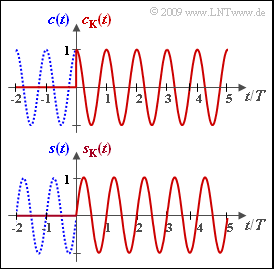Exercise 3.6: Transient Behavior
In this exercise, we consider a cosine signal c(t) with amplitude 1 and period T=1 µs, which is defined for all times t (in the range ±∞) :
- c(t)=cos(2π⋅t/T).
In contrast, the causal cosine signal cK(t) (red curve) starts only at the turn-on instant t=0:
- cK(t)={c(t)0f¨urf¨urt≥0,t<0.
Only the Fourier spectrum can be specified for the bilaterally unbounded signal c(t) :
- C(f)=1/2⋅δ(f−f0)+1/2⋅δ(f+f0)withf0=1/T=1MHz.
On the contrary, for the causal cosine signal cK(t) the Laplace transform can also be specified:
- CL(p)=p(p−j⋅2π/T)⋅(p+j⋅2π/T).
Accordingly, the following holds for the Laplace transform of the causal sine function sK(t):
- SL(p)=2π/T(p−j⋅2π/T)⋅(p+j⋅2π/T).
The bilaterally unbounded sine function is denoted by s(t) and is shown as a blue–dotted curve in the diagram below.
The signals c(t), cK(t), s(t) and sK(t) are applied to the input of a low-pass filter of first-order with the following transfer function (or impulse response):
- HL(p)=2/Tp+2/T∙−−L−∘h(t)=2/T⋅e−2t/T.
- The corresponding output signals are denoted by yC(t), yCK(t), yS(t) and ySK(t) .
- These signals are to be computed and correlated to each other in this exercise.
Please note:
- The exercise belongs to the chapter Inverse Laplace Transform.
- The computations for subtask (6) are bulky.
- For computing the signals yCK(t) and ySK(t), for example the residue theorem can be used.
Questions
Solution
- H(f)=2/Tj⋅2πf+2/T=f0j⋅πf+f0⇒H(f=f0)=11+j⋅π
- ⇒|H(f=f0)|=1√1+π2=0.303_,a(f=f0)=−ln|H(f=f0)|≈1.194Np_
- ⇒arcH(f=f0)=−arctan(π)≈−72∘_,b(f=f0)=−arcH(f=f0)≈+72∘_.
(2) Das Ausgangssignal yC(t) ist gegenüber dem Eingangssignal c(t) um den Faktor 0.303 gedämpft und um τ≈72/360⋅T=T/5 verzögert.
Man kann dieses Signal somit auch folgendermaßen beschreiben:
- yC(t)=cos(2πt/T)+π⋅sin(2πt/T)1+π2=0.303⋅cos(2π⋅t−T/5T)⇒yC(t=0)=11+π2≈0.092_.
Dieses Signal ist in der linken Grafik zur Musterlösung (5) blau–gepunktet dargestellt.
(3) Das Signal yS(t) ist gegenüber s(t) ebenfalls um den Dämpfungsfaktor 0.303 kleiner und um die Zeitdauer τ=T/5 verzögert.
Es lässt sich wie folgt beschreiben:
- yS(t)=−π⋅cos(2πt/T)+sin(2πt/T)1+π2=0.303⋅sin(2π⋅t−T/5T)⇒yS(t=0)=−π1+π2≈−0.289_.
Dieses Signal ist in der rechten Grafik zur Musterlösung (5) blau–gepunktet skizziert.
(4) Bei Th soll die Impulsantwort h(t) auf 1% des Maximalwertes abgeklungen sein. Somit gilt:
- e−2Th/T=0.01⇒Th/T=12⋅ln10.01≈2.3_⇒h(t=0)=2/T,h(t=Th)=0.02/T.
(5) Richtig sind die Aussagen 1 und 2:
- Die kausalen Signale yCK(t) und ySK(t) müssen für t<0 identisch Null sein.
- Da aber die Impulsantwort h(t) des betrachteten Filters für t>Th (nahezu) verschwindet, ist es nach Abschluss des Einschwingvorganges egal, ob das zeitlich unbegrenzte Cosinussignal c(t) oder das kausale Signal cK(t) am Eingang anliegt.
- Das gleiche gilt für die Sinussignale: Für t>Th ist ySK(t)=yS(t).
Die Grafik zeigt links die Ausgangssignale yC(t) und yCK(t) bei cosinusförmigem Eingang und rechts die Signale yS(t) und ySK(t) bei sinusförmigem Eingang. Beachten Sie die Laufzeit von T/5 (entsprechend der Phase 72∘) in beiden Fällen.
- Bei yCK(t) sind die ersten Wellenberge kleiner als 1, um die richtige Phasenlage von yC(t) zu erreichen.
- Bei ySK(t) sind dagegen die ersten Wellenberge größer als 1, um die richtige Phasenlage von yS(t) zu erreichen.
(6) Mit
px1=j⋅2π/T,px2=−j⋅2π/T,px3=−2/T
kann für die Laplace–Transformierte des Signals yCK(t) geschrieben werden:
- YL(p)=−px3⋅p(p−px1)(p−px2)(p−px3).
Die Zeitfunktion yCK(t) setzt sich somit nach dem Residuensatz aus drei Anteilen zusammen:
- Der erste Anteil ergibt sich unter Berücksichtigung von px2=−px1 zu
- y1(t)=Res|p=px1{YL(p)⋅ept}=−px3⋅p(p−px2)(p−px3)⋅ept|p=px1=−px3⋅px1(px1−px2)(px1−px3)⋅epx1⋅t=−px3/2px1−px3⋅epx1⋅t.
- In gleicher Weise erhält man für den zweiten Anteil:
- y2(t)=Res|p=px2{YL(p)⋅ept}=−px3⋅p(p−px1)(p−px3)⋅ept|p=px2=−px3⋅px2(px2−px1)(px2−px3)⋅epx2⋅t=px3/2px1+px3⋅e−px1⋅t.
- Fasst man beide Anteile zusammen und berücksichtigt die Zahlenwerte von px1 und px3, so erhält man
- y1+2(t)=1/T2/T+j⋅2π/T⋅ej⋅2πt/T+1/T2/T−j⋅2π/T⋅e−j⋅2πt/T=1/21+j⋅π⋅ej⋅2πt/T+1/21−j⋅π⋅e−j⋅2πt/T
- ⇒y1+2(t)=1/2⋅(1−j⋅π)1+π2⋅ej⋅2πt/T+1/2⋅(1+j⋅π)1+π2⋅e−j⋅2πt/T.
- Mit Hilfe des Eulerschen Satzes kann hierfür auch geschrieben werden:
- y1+2(t)=cos(2πt/T)+π⋅sin(2πt/T)1+π2=yC(t).
Man erkennt, dass y1+2(t) gleich dem in der Teilaufgabe (2) berechneten Signal yC(t) ist.
- Schließlich erhält man für das letzte Residuum:
- y3(t)=−p2x3(px3−px1)(px3−px2)⋅epx3⋅t=−(2/T)2⋅e−2t/T(−2/T−j⋅2π/T)(−2/T+j⋅2π/T)=−e−2t/T(1+j⋅π)(1−j⋅π)=−e−2t/T1+π2.
- Damit lautet das Ausgangssignal bei kausalem Cosinussignal am Eingang:
- yCK(t)=y1(t)+y2(t)+y3(t)=cos(2πt/T)+π⋅sin(2πt/T)−e−2t/T1+π2
- ⇒yCK(t=T/5)=cos(72∘)+π⋅sin(72∘)−e−0.41+π2≈0.24_<0.303.
- Zum Vergleich: Das Signal yC(t) hat zu diesem Zeitpunkt den Wert 0.303.
- Dagegen ergibt sich beim kausalen Sinussignal am Eingang allgemein und speziell zum Zeitpunkt des ersten Maximums bei t=0.45⋅T:
- ySK(t)=−π⋅cos(2πt/T)+sin(2πt/T)+π⋅e−2t/T1+π2
- ⇒ySK(t=0.45⋅T)=−π⋅cos(162∘)+sin(162∘)+π⋅e−0.91+π2≈0.42>0.303.

